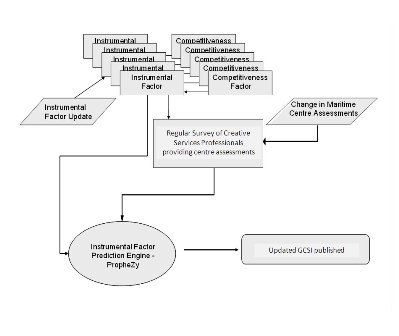Global Creative Services Index (GCSI)
Proposal
The creative services industry includes firms and people creating communication in several media: advertising, graphic design, public relations, film and video, interactive media and software (including video games). It also includes independent artists, writers and performers along with photographers and other producers of imagery.
The creative services industries thus contribute to local and international economies, provide cultural benefits to the community and bring national and international visibility. It is not therefore surprising that cities seek to promote their attractiveness to the creative industries. A measure of city competitiveness to the creative services sector would be an invaluable tool to policy makers, those who seek to encourage inward investment and those in the industry itself.
Objective
To provide a dynamic view of creative service centre competitiveness covering a wide variety of centres (e.g. London, New York, Barcelona, … perhaps 30 to 60 cities globally) with a dynamic interpretation of changes in the input factors and their effects on creative service activity.
Approach
The approach suggested would be similar to another type of index that Z/Yen have developed, the Global Financial Centres Index (GFCI) - Long Finance
The Global Creative Services Index (GCSI) would provide ratings of the competitiveness of different countries for the creative services industry. These ratings would be calculated by a ‘factor assessment model’ built using two distinct sets of input:
- instrumental factors - drawn from external sources. An instrumental factor is a measurable indicator or ‘proxy’ for something that cannot be directly measured. For example, ‘Business Building Capacity’ might be represented by Grant Thornton’s Super Growth Companies Index, the Economist Intelligence Unit’s Business Environment Ranking and the Heritage Foundation’s Index of Economic Freedom. Not all countries will have data for all instrumental factors and the statistical model would take account of these gaps;
- country assessments - to construct the first set of GCSI ratings we would use assessments drawn from respondents to an online survey. Respondents (including, for example, client side marketing directors and advertising agency professionals) would assess the competitiveness of the countries which they knew. The online survey would run continuously to keep the GCSI up-to-date with people’s changing assessments.
Every time new assessments arrive, or instrumental factors change, the index can updated, though we recommend that the GCSI be updated and reissued half-yearly.
Analytical Engine
The GCSI would be based upon a component factor model and an outline of the basic process is the following diagram:

The country assessments and instrumental factors are used to build a predictive model of country competitiveness for creative services using support vector machine (SVM) mathematics. The SVM used for the building of the GCSI would be PropheZy – Z/Yen’s proprietary system. SVMs are based upon statistical techniques that classify and model complex historic data in order to make predictions on new data. The SVM used for the GCSI would provide information about the confidence with which each specific classification is made and the likelihood of other possible classifications. The predictive model provides the overall index by answering questions such as:
If an international marketing director gives France and UK certain assessments of competitiveness then, based on the instrumental factors for France, UK and Italy, how would that person assess Italy?
From these calculated ratings, the overall index numbers would be generated.
Output
The GCSI would provide a regular evaluation of changes in city competitiveness. It would generate regular news and analysis. There is the potential to build a community/club of a few thousand global creative services professionals globally into an effective, albeit changing group, centred around London, yet independent and holding strong local interests.
We would propose that the web-based survey of the ‘club’ be done, ideally, on a quarterly basis. The idea would be to get a group together such that at least 400 responses could be gained per annum, at least 100 per quarter, with the assistance of contacts and networks.
This document is designed to initiate conversation. Z/Yen is interested in exploring these issues further with all parties. Please contact Mark Yeandle, Associate Director, Z/Yen Group Limited, Mark_Yeandle@zyen.com